I was puttering around in the yard when I realized that we sure have a lot of random crap around our yard. I guess you can’t call it crap because it’s all really, really useful stuff. None of these items’ primary use is for gardening or livestock keeping but here we are using them all the time. So here’s my list of items that you should keep around if you are an avid gardener or own livestock.
 5 Gallon Buckets
5 Gallon Buckets
I honestly don’t know how I ever got through life without 5 gallon buckets. The food grade ones are awesome for storing food of course, though you need to take care to keep rodents out, but even the non-food grade ones are indispensable. I use them to mix potting soil, tools, irrigation supplies and pipe, and garden supplies. I also use them for harvesting larger amounts that my basket can’t handle (like the 70lbs of apricots we harvested this past weekend) and for collecting weeds in when I’m weeding. You can upend a bucket over a tender plant overnight if you’re suspecting a frost (just remember to remove it in the morning). We also cut them down, hook up a float and use them as automatic waterers (a very wise goat breeder told me that goats prefer to drink out of white buckets). You can even use them to make self watering planters!
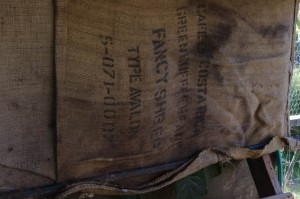 Burlap Bags
Burlap Bags
These are the big bags that they ship coffee beans in. You can ask your local coffee roaster if they have any they can give you or sometimes the dump has pallets of them. We use them as weedblock (doesn’t work very well for bindweed or Bermuda grass though) and in our mushroom garden to keep logs moist. For events we use them as rustic table cloths but when we’re home they are useful for anything we need fabric for outside use. With the animals it works well for insulation on cold nights and for calming animals in distress when we have to isolate them. We also use it to help keep the chickens from sleeping in their nest boxes at night (in picture). By nailing one edge above the nest boxes and attaching a heavy bar to the opposite edge we can roll it up in the morning and bring it back down in the evening when everyone is done laying. Helps keep the boxes nice and clean because the girls can’t sleep in the boxes. Additionally you can use them as temporary planters by setting them upright filled with soil. The jury is still out though on whether they are good for potatoes.
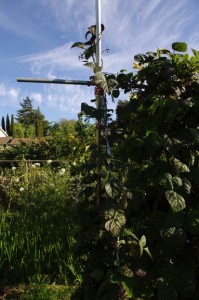 Electrical Conduit
Electrical Conduit
This is probably one of the most useful items we have around here. Tom works for an electrical wholesaler and so any bent pieces they receive he squirrels away until he has enough to bring home. We use it for making trellises for climbing veggies. When making trellises you lash together two pipes (pound them into the ground some) on each end of the bed and then stabilize them with a pipe running through the crook made by the ends. Lash it all together and it should be pretty stable. Then we use line to run back and forth or up and down depending on what we’re planting. Beans and other twining veggies get a vertical trellis while grasping vines like peas, cukes and squash, get a horizontal trellis. Polyester line works well but we like to use the lines off of hay bales because they are stronger and last longer. Electrical conduit also works well for fence posts. When it involves keeping chickens out they are too thin for the chickens to jump up onto. We use it as the “rails” in our feed mangers for the goats and we even used it for building the chicken run. It is strong enough to support the wire that covers the run and was easily attached to the posts with pipe straps.
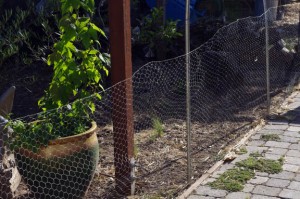 Stucco Wire
Stucco Wire
Similar to chicken wire, stucco wire is cheaper and stronger (after all, it has to hold the weight of stucco to a buildings). We primarily use it for temporary fencing and of course for poultry housing. It’s also good to wrap around newly planted plants to keep critters from digging them up. We use it in planters to keep the squirrels out and then we also tie scare tape to it to keep the birds away from by blueberries. It’s useful to use to for impromptu compost bins by wiring it into a circle because it allows for lots of airflow. It’s also a cheaper alternative to hardware cloth under raised beds to keep gophers out and also as cages under new trees and shrubs that you may plant to also keep gophers away.
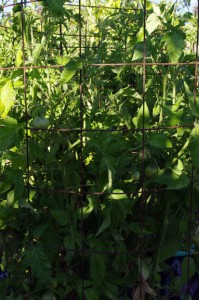 Concrete Reinforcement Fabric
Concrete Reinforcement Fabric
By far the BEST tomato cages available are the ones you make at home from a wire mesh meant for pouring concrete slabs. The spacing between the wire is perfect for reaching your hand through to pick even the biggest tomato but it’s also strong enough not to collapse under even the largest plant. We also use this mesh for tomatillos and you can make nice arbors with them. We’ve had ours for well over 5 years with no issues. At the end of the season you can open them back up and lay them flat or stack them in an out of the way place, which is what we do. There’s also an option to cut them into four pieces of equal size and then wire them into square cages which can lay flat for storage.
It also works well for potato towers because it’s strong enough to hold hay, soil and lots of potatoes!
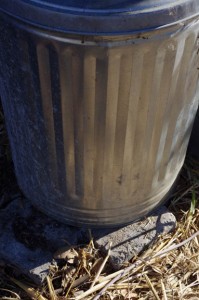 Concrete Pavers or Bricks
Concrete Pavers or Bricks
We put in a patio in our backyard and ended up with a whole bunch of leftover pavers. People are always trying to offload extra brick and pavers on Craigslist and Freecycle so they are fairly easy to obtain. They can be used as small stepping stones through the garden if you don’t want to put down a path and just want something temporary. We also use them whenever we need a hard, level surface such as under water buckets. They are great for keeping wood and metal off of the ground as well. While galvanized metal is rust resistant it isn’t rust proof so we like to keep our metal pails on the pavers to reduce their contact with moisture from the soil. I also find them helpful protect our irrigation system, particularly where the risers come out of the ground. We stack them around the risers so that we don’t trip on them (makes them more visible) and also to keep us from damaging the rises with tools or wheelbarrows.
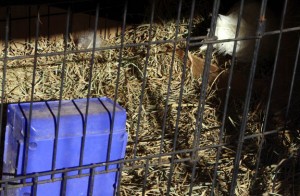 XL Wire Dog Grate
XL Wire Dog Grate
If you have livestock this is a must-have item. We have two of them plus a wire pen and all of them are in constant use around here. For rabbits they work well as temporary pens when you’re cleaning out hutches or just want to give them some time in the grass to play. We use the pen most often for this because it’s large enough to let them romp around. If you have chickens (same for turkeys and ducks) they are great for brooding chicks in. Unlike plastic dog crates, the wire ones have a removable bottom tray so you can get those chicks on the dirt as soon as possible. Plus this eliminates a slick footing which can cause splay leg in your chicks. They are also great for isolating a hen if she’s injured or broody, without separating her from her flock which is much less stressful. For goats it’s perfect for keeping the kids off of mom at night if you’re milking her in the morning. They sleep comfortably while still in full view of mom. I also use the crate for transporting the goats to the vet or breeder. It’s large enough for two dwarf goats to move around plus water and food.
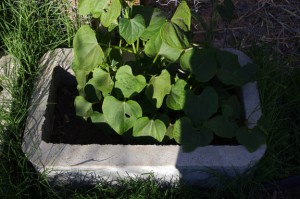 Concrete Christy Boxes
Concrete Christy Boxes
These are the those boxes you see set flush in the sidewalk that have a concrete cover over them that usually says something like “Electrical” or “Water Meter.” They come in all different sizes from several feet long to 9″ rounds. The larger ones are the most useful for us as they make great deep raised beds in small spaces. The bonus is that they are concrete so they don’t disintegrate over time. They are also small enough to move around.
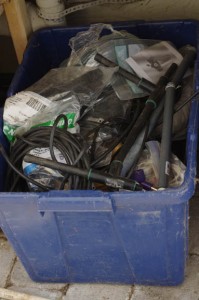 Old Recycle Bins
Old Recycle Bins
Remember back in the day when the recycle bins were just a small crate that you carried out to the curb? When we moved into our house we found over half a dozen of these boxes in our backyard. They’ve turned out to be extremely useful to us. We use the majority of them as storage bins for garden and irrigation supplies. We use them when weeding large areas because they are great for storing a lot of weeds between dumping. Flip them over and use them as a garden seat. We keep them out in the goat yard to either sit on or let the kids play on or in. I can also foresee making nest boxes out of them in the chicken house. Because they already have drainage holes in the bottom they can work as movable planters. Drill large holes in the sides, fill up with coffee grounds and grow oyster mushrooms in them as well. The uses are endless with these.
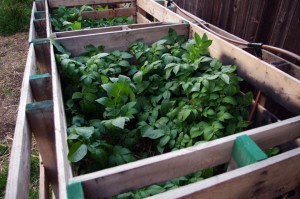 Pallets
Pallets
The ubiquitous pallet can be had for free from many places. Tom’s work can’t get rid of them fast enough and has stacks of them in their yard waiting to find a new home. Pallets have been getting a lot of attention lately for their usefulness in the garden. From making vertical garden walls to temporary beds for lettuces they have a multitude of uses. We use them for a lot of things here. We built Turkey Town almost entirely out of pallets and burlap. We store our hay on them and we made a hive stand with one. We used them to make our potato bins, which we’re hoping increased yield this year. The uses of pallets are only limited to your imagination.


Great article, thanks for the tips. I’m definitely going to look for stucco wire instead of chicken wire from now on.
I’m curious as to your thoughts on the potential chemicals in the wooden pallets. I’ve always just assumed that pallets used treated wood (like railroad ties soaked in creosote) and I’ve avoided using them. But I would love to be able to eliminate that nagging doubt in the back of my head and start using pallets for all sorts of projects.
I love your blog, and appreciate all the useful information you post. Many thanks!
Most are heat treated. Here’s a good instructable on how to figure out how a pallet is treated: http://www.instructables.com/id/How-to-determine-if-a-wood-pallet-is-safe-for-use/
Thanks so much for that link. Good info. I just might go pallet hunting now.
Rachel, any suggestions on finding 5 gallon buckets on the cheap? And how can I tell if it’s food-grade or not? Thanks!!
Food grade buckets are easiest to find by going to delis, bakeries, grocery stores, or restaurants and just ask for their old buckets. Sometimes you can also find them on Craigslist. If it’s previously held food then it’s food-grade.
I love the potato bins made from pallets!! I am going to try that and use hardware cloth on the interior to keep out the moles. We also use 5 gal buckets all the time. I’ve never heard of the christy boxes and wondered if they were expensive? I have seen large diameter terracotta piping used buried partially in the ground for invasive herbs. Enjoy your posts.
You can sometimes get Christy boxes for free from contractors. You can also try asking wholesalers if they have any seconds they want to get rid of.
Love your burlap nest box idea. I have a broody hen right now who’s outside in the run during the day, but is sleeping in the nest box at night. I’m going to try the burlap/heavy bar combo. Do you actually attach the bar (how?) or just put it inside at the bottom of the bag?
I tried potatoes in burlap last year; the bags broke down too fast and the whole thing didn’t work quite as I imagined, but I did get a few spuds.
We just attached the bar with some baling wire to the fabric. I think just sliding it into the fabric it might slide out.
I LOVE 5 gallon buckets. I use them for all kind of things. I’ll have to try them for the goats water too. : )
Ooh, pretty please post to Punk Domestics?
Done!
Great post, I love the 5 gallon buckets too, I am always eyeing them when I see them unused at a friends house LOL.